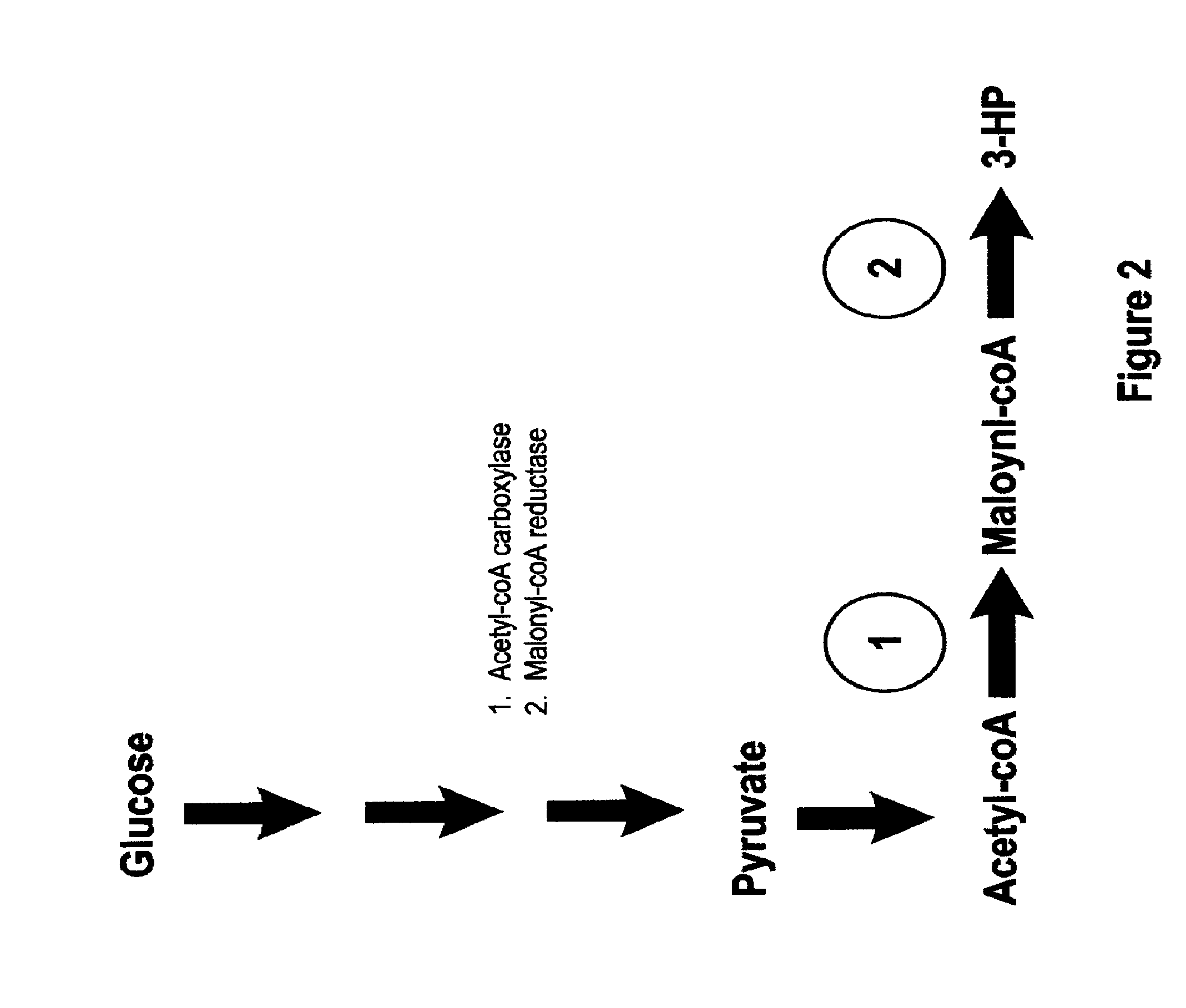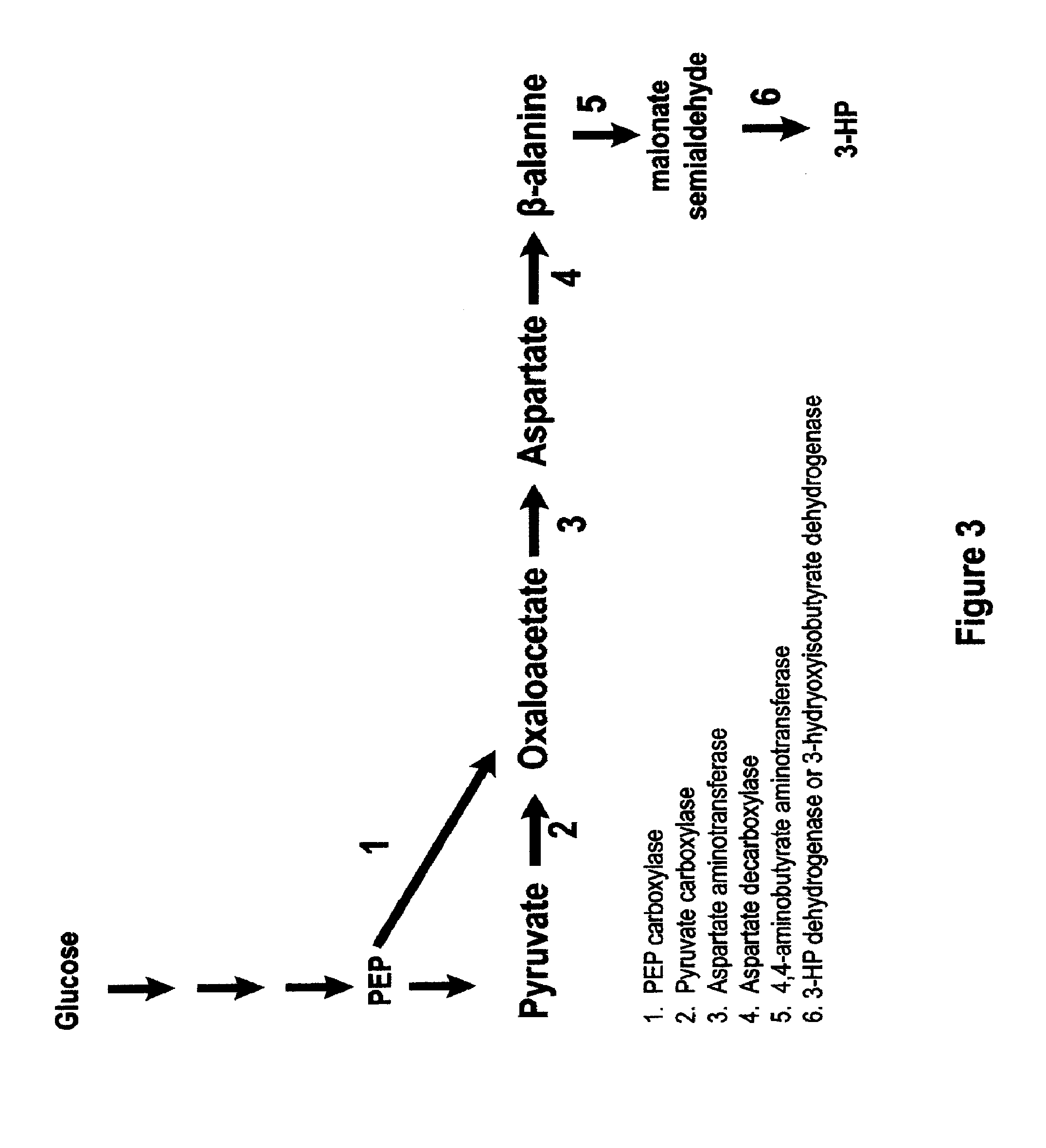Methods, Systems And Compositions Related To Reduction Of Conversions Of Microbially Produced 3-Hydroxypropionic Acid (3-HP) To Aldehyde Metabolites
a technology of microbial production and conversion, applied in the field of genetically modified microorganisms, can solve the problems of cumbersome identification of genes, enzymes, pathway portions and/or whole metabolic pathways that are related to a particular phenotype of interest, and achieve the effect of reducing the metabolism of 3-hp and reducing the enzymatic conversion of microbials
- Summary
- Abstract
- Description
- Claims
- Application Information
AI Technical Summary
Problems solved by technology
Method used
Image
Examples
example 1
E. coli Mutants with Decreased Conversion of 3-HP to an Aldehyde
[0190]The control E. coli strain BW25113 and 22 of its derivatives, each derivative having a deletion of a respective one of 22 aldehyde dehydrogenases or related genes (predicted aldehyde dehydrogenases via homology, www.ecocyc.org) were cultured as described in methods in the Common Methods Section. Strains were obtained from the Keio collection that had deletions of the aldehyde dehydrogenase genes listed in Table 1, which provides sequence listing numbers of 22 genes (SEQ ID NOs. 1-22) and the amino acid sequences encoded by these genes (SEQ ID NOs. 23-44). The Keio collection was obtained from Open Biosystems (Huntsville, Ala. USA 35806). These strains each contain a kanamycin marker in place of the deleted gene. For more information concerning the Keio Collection and the curing of the kanamycin cassette please refer to: Baba, T et al (2006). Construction of Escherichia coli K12 in-frame, single-gene knockout mutan...
example 2
Preparation and Evaluation Over-Expressed Dehydrogenases
[0193]Aldehyde dehydrogenase genes were amplified by PCR from genomic E. coli DNA using the primers in Table 3 (SEQ ID NOs. 045 to 118) for the respective genes of Table 1. Open reading frames (ORFs) were amplified from the start codon to the amino acid preceding the stop codon to allow for expression of the hexa-histidine tag encoded by the vector. PCR products were isolated by gel electrophoresis and gel purified using Qiagen gel extraction (Valencia, Calif. USA, Cat. No. 28706) following the manufacturer's instructions. Gel purified dehydrogenase gene open reading frames (see Table 1 for SEQ ID NOs) were then cloned into pTrcHis2-Topo vector (SEQ ID NO:119), Invitrogen Corp, Carlsbad, Calif., USA) following manufacturer's instructions. DNA was transformed and cultured. Subsequently, DNA from colonies was miniprepped and screened by restriction digestion. All isolated plasmids were sequenced verified by the DNA sequencing ser...
example 3
Preparation and Evaluation of E. coli Modified to Disrupt Aldehyde Dehydrogenase Genes and Having 3-HP Production Genetic Modification
[0202]Construction of pSC-B-Ptpia:mcr
[0203]The protein sequence (SEQ ID NO:122) of the malonyl-coA reductase gene (mcr) from Chloroflexus aurantiacus was codon optimized for E. coli according to a service from DNA 2.0 (Menlo Park, Calif. USA), a commercial DNA gene synthesis provider. This synthetic codon-optimized nucleic acid sequence was synthesized with an EcoRI restriction site before the start codon and also comprised a HindIII restriction site following the termination codon. In addition a Shine Delgamo sequence (i.e., a ribosomal binding site) was placed in front of the start codon preceded by the EcoRI restriction site. This gene construct was synthesized by DNA 2.0 and provided in a pJ206 vector backbone. This plasmid, comprising this codon-optimized nucleic acid sequence for mcr, was designated pJ206:mcr (SEQ ID NO:123). This synthesized pl...
PUM
| Property | Measurement | Unit |
|---|---|---|
| temperature | aaaaa | aaaaa |
| temperature | aaaaa | aaaaa |
| pH | aaaaa | aaaaa |
Abstract
Description
Claims
Application Information
 Login to View More
Login to View More - R&D
- Intellectual Property
- Life Sciences
- Materials
- Tech Scout
- Unparalleled Data Quality
- Higher Quality Content
- 60% Fewer Hallucinations
Browse by: Latest US Patents, China's latest patents, Technical Efficacy Thesaurus, Application Domain, Technology Topic, Popular Technical Reports.
© 2025 PatSnap. All rights reserved.Legal|Privacy policy|Modern Slavery Act Transparency Statement|Sitemap|About US| Contact US: help@patsnap.com



